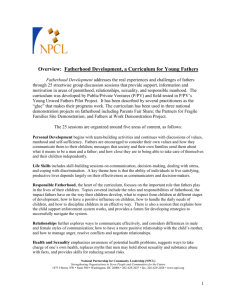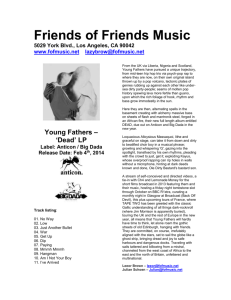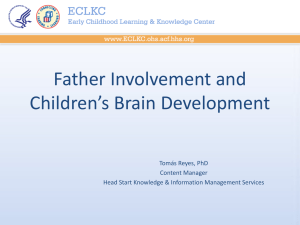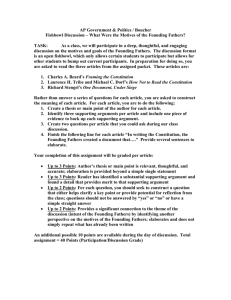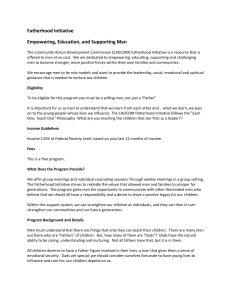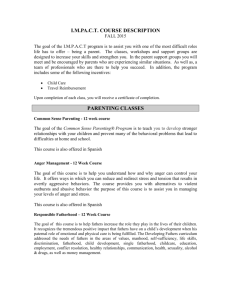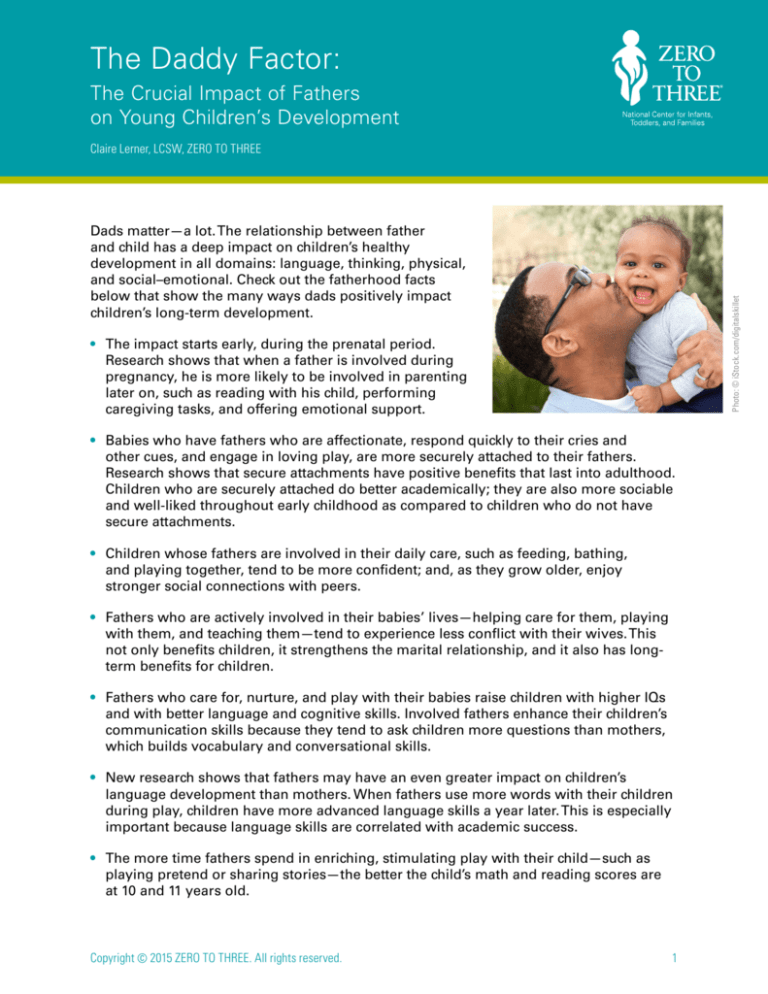
The Daddy Factor:
The Crucial Impact of Fathers
on Young Children’s Development
Claire Lerner, LCSW, ZERO TO THREE
Photo: © iStock.com/digitalskillet
Dads matter—a lot. The relationship between father
and child has a deep impact on children’s healthy
development in all domains: language, thinking, physical,
and social–emotional. Check out the fatherhood facts
below that show the many ways dads positively impact
children’s long-term development.
• The impact starts early, during the prenatal period.
Research shows that when a father is involved during
pregnancy, he is more likely to be involved in parenting
later on, such as reading with his child, performing
caregiving tasks, and offering emotional support.
• Babies who have fathers who are affectionate, respond quickly to their cries and
other cues, and engage in loving play, are more securely attached to their fathers.
Research shows that secure attachments have positive benefits that last into adulthood.
Children who are securely attached do better academically; they are also more sociable
and well-liked throughout early childhood as compared to children who do not have
secure attachments.
• Children whose fathers are involved in their daily care, such as feeding, bathing,
and playing together, tend to be more confident; and, as they grow older, enjoy
stronger social connections with peers.
• Fathers who are actively involved in their babies’ lives—helping care for them, playing
with them, and teaching them—tend to experience less conflict with their wives. This
not only benefits children, it strengthens the marital relationship, and it also has longterm benefits for children.
• Fathers who care for, nurture, and play with their babies raise children with higher IQs
and with better language and cognitive skills. Involved fathers enhance their children’s
communication skills because they tend to ask children more questions than mothers,
which builds vocabulary and conversational skills.
• New research shows that fathers may have an even greater impact on children’s
language development than mothers. When fathers use more words with their children
during play, children have more advanced language skills a year later. This is especially
important because language skills are correlated with academic success.
• The more time fathers spend in enriching, stimulating play with their child—such as
playing pretend or sharing stories—the better the child’s math and reading scores are
at 10 and 11 years old.
Copyright © 2015 ZERO TO THREE. All rights reserved. 1
The Daddy Factor: How Fathers Support Young Children’s Development
• Children with involved fathers tend to be more patient; and, when they are older,
they can handle the stresses and frustrations associated with schooling more easily
than children with less involved fathers.
• The rough-and-tumble kind of play that fathers engage in with their young children
helps them regulate their feelings and behavior. It teaches children how to deal with
aggressive impulses and physical contact in socially acceptable ways.
• And finally, children of involved fathers are less likely to get in trouble at home, in
school, and in the neighborhood, and they are less likely to experience depression.
References
• Bronte-Tinkew, J., Ryan, S., Carrano, J., & Moore, K. A. (2007). Resident fathers’ pregnancy intentions, prenatal behaviors,
and links to involvement with infants. Journal of Marriage and Family, 69, 977–990.
• Cabrera, N. J., Shannon, J. D., & Tamis-LeMonda, C. (2007). Fathers’ influence on their children’s cognitive and emotional
development: From toddlers to pre-K. Applied Developmental Science, 11(4), 208–213. Retrieved from http://steinhardt.nyu.edu/
scmsAdmin/uploads/006/903/Cabrera,%20N.%20J.,%20Shannon,%20J.%20D.,%20%26%20Tamis-LeMonda,%20C.,%20
Applied%20Dev.%20Sci.,%202007.pdf
• Cabrera, N., Shannon, J., West, J., & Brooks-Gunn, J. (2006). Parental interactions with Latino infants: Variation by country
of origin and English proficiency. Child Development, 74, 1190–1207.
• Cook, G. A., Roggman, L. A., & Boyce, L. K. (2012). Fathers’ and mothers’ cognitive stimulation in early play with toddlers:
Predictors of 5th grade reading and math. Family Science, 2(2), 131–145.
• Fagan, J., & Cabrera, N. (2012). Longitudinal reciprocal associations between coparenting conflict and father engagement.
Brief Report published in Journal of Family Psychology. 26, 1004–1011. doi: 10.1037/a0029998
• Harris, K. M., & Marmer, J. K. (1996). Poverty, paternal involvement, and adolescent well-being. Journal of Family Issues,
17(5), 614–640.
• Pancsofar, N., & Vernon-Feagans, L. (2010). Fathers’ early contributions communities. Early contributions to children’s language
development in families from low-income rural communities. Early Childhood Research Quarterly, 25(4), 450–463.
• Pleck, J. H. (1997). Paternal involvement: Levels, sources, and consequences. In M. E. Lamb (Ed.), The role of fathers in child
development (3rd ed., pp. 66–103). New York, NY: John Wiley & Sons.
• Pougnet, E., Serbin, L. A., Stack, D. M., & Schwartzman, A. E. (2011). Fathers’ influence on children’s cognitive and behavioural
functioning: A longitudinal study of Canadian families. Canadian Journal of Behavioural Science/ Revue canadienne des
sciences du comportement, 43(3), 173–182. Abstract retrieved from http://psycnet.apa.org/journals/cbs/43/3/173/
• Pruett, K. (2000). Father-need. New York, NY: Broadway Books.
• Rasciot, J. (2012). Study: Playing with your toddler can boost academic success. Retrieved from http://blogs.edweek.org/
edweek/early_years/2012/03/study_playing_with_your_toddler_can_boost_academic_success.html
• Rosenberg, J., & Wilcox, W. B. (2006). The importance of fathers in the healthy development of children. Retrieved from
U. S. Department of Health and Human Services. https://www.childwelfare.gov/pubs/usermanuals/fatherhood/fatherhood.pdf
• Yeung, W. J., Duncan, G. J., & Hill, M. S. (2000). Putting fathers back in the picture: Parental activities and children’s adult
outcomes. In H. E. Peters, G. W. Peterson, S. K. Steinmetz, & R. D. Day (Eds.), Fatherhood: Research, interventions and policies
(pp. 97–113). New York, NY: Hayworth Press.
Copyright © 2015 ZERO TO THREE. All rights reserved.
2

